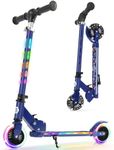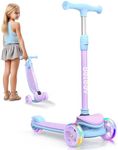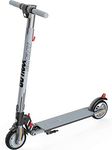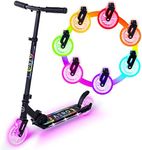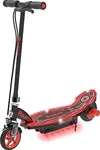Buying Guide for the Best E Scooter For Kids
Choosing an e-scooter for kids is an exciting process, but it’s important to focus on safety, ease of use, and suitability for your child’s age and abilities. Start by thinking about where your child will ride the scooter—on sidewalks, in parks, or around your neighborhood. Always prioritize features that make the scooter safe and comfortable for kids, and remember that the best e-scooter is one that matches your child’s size, skill level, and riding environment.Maximum SpeedMaximum speed refers to how fast the e-scooter can go. For kids, this is a crucial safety factor. Lower speeds (around 6-10 mph) are best for younger children or beginners, as they are easier to control and reduce the risk of injury. Slightly higher speeds (up to 12-15 mph) may be suitable for older or more experienced kids, but always consider your child’s confidence and the riding environment. Choose a speed that matches your child’s age, experience, and where they’ll be riding.
Weight LimitThe weight limit tells you the maximum rider weight the scooter can safely support. This is important for both safety and performance. Scooters with lower weight limits (up to 100 lbs) are designed for younger, lighter children, while higher limits (up to 150 lbs or more) can accommodate older kids or those who are growing quickly. Always check your child’s weight and choose a scooter that can support them comfortably, with some room for growth.
Battery Life and RangeBattery life and range indicate how far the scooter can travel on a single charge. Shorter ranges (3-5 miles) are usually enough for quick rides around the block or to a nearby park, while longer ranges (6-10 miles or more) are better for kids who want to ride further or for longer periods. Think about how your child will use the scooter and pick a range that fits their typical riding habits, so they don’t run out of power mid-ride.
Wheel Size and TypeWheel size and type affect how smooth and stable the ride feels. Smaller wheels (around 5-6 inches) are lighter and easier for young kids to handle, but may not handle bumps as well. Larger wheels (7-8 inches or more) offer a smoother ride and better stability, especially on uneven surfaces. Solid wheels are puncture-proof and low-maintenance, while air-filled tires provide more comfort but need occasional upkeep. Choose based on your child’s age and where they’ll be riding most often.
Braking SystemThe braking system is how your child will stop the scooter. Common types include foot brakes (step on the rear fender), hand brakes (like a bicycle), or electronic brakes. Foot brakes are simple and reliable for younger kids, while hand or electronic brakes offer more control for older or more experienced riders. Consider your child’s coordination and comfort with different braking styles when making your choice.
Adjustable Handlebar HeightAdjustable handlebars let you change the height to fit your child as they grow. This is important for comfort and control, ensuring the scooter isn’t too tall or too short. Look for scooters with a good range of adjustment, especially if your child is still growing or if the scooter will be shared between siblings of different heights.
Weight of the ScooterThe weight of the scooter affects how easy it is for your child to handle, carry, or store. Lighter scooters (under 20 lbs) are easier for younger kids to manage, while heavier models may be sturdier but harder to lift. Think about whether your child will need to carry the scooter up stairs or lift it into a car, and choose a weight that matches their strength and needs.




